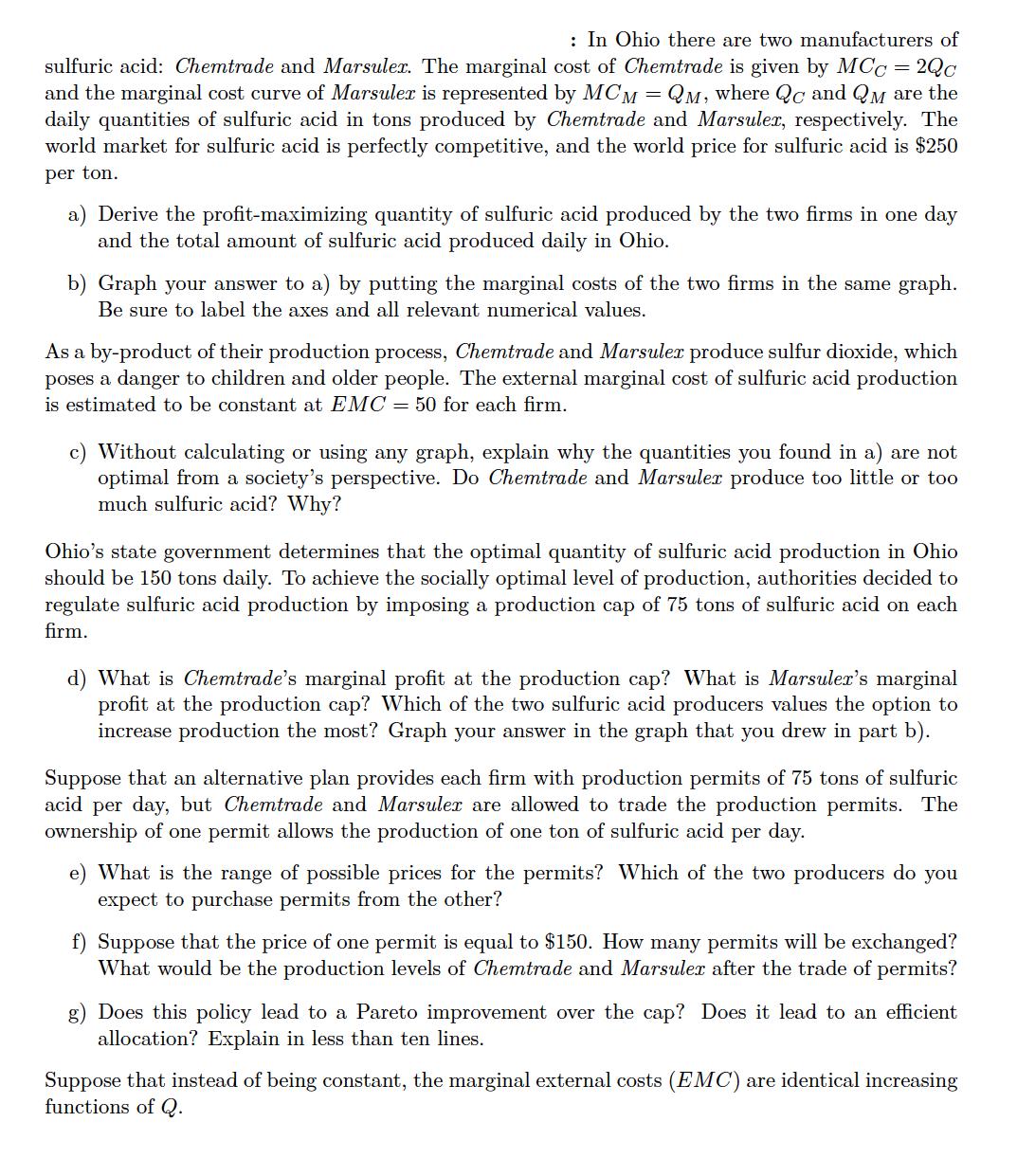Answered step by step
Verified Expert Solution
Question
1 Approved Answer
: In Ohio there are two manufacturers of sulfuric acid: Chemtrade and Marsulex. The marginal cost of Chemtrade is given by MCC = 2Qc


: In Ohio there are two manufacturers of sulfuric acid: Chemtrade and Marsulex. The marginal cost of Chemtrade is given by MCC = 2Qc and the marginal cost curve of Marsuler is represented by MCM = QM, where Qc and QM are the daily quantities of sulfuric acid in tons produced by Chemtrade and Marsulex, respectively. The world market for sulfuric acid is perfectly competitive, and the world price for sulfuric acid is $250 per ton. a) Derive the profit-maximizing quantity of sulfuric acid produced by the two firms in one day and the total amount of sulfuric acid produced daily in Ohio. b) Graph your answer to a) by putting the marginal costs of the two firms in the same graph. Be sure to label the axes and all relevant numerical values. As a by-product of their production process, Chemtrade and Marsulex produce sulfur dioxide, which poses a danger to children and older people. The external marginal cost of sulfuric acid production is estimated to be constant at EMC = 50 for each firm. c) Without calculating or using any graph, explain why the quantities you found in a) are not optimal from a society's perspective. Do Chemtrade and Marsuler produce too little or too much sulfuric acid? Why? Ohio's state government determines that the optimal quantity of sulfuric acid production in Ohio should be 150 tons daily. To achieve the socially optimal level of production, authorities decided to regulate sulfuric acid production by imposing a production cap of 75 tons of sulfuric acid on each firm. d) What is Chemtrade's marginal profit at the production cap? What is Marsulex's marginal profit at the production cap? Which of the two sulfuric acid producers values the option to increase production the most? Graph your answer in the graph that you drew in part b). Suppose that an alternative plan provides each firm with production permits of 75 tons of sulfuric acid per day, but Chemtrade and Marsulex are allowed to trade the production permits. The ownership of one permit allows the production of one ton of sulfuric acid per day. e) What is the range of possible prices for the permits? Which of the two producers do you expect to purchase permits from the other? f) Suppose that the price of one permit is equal to $150. How many permits will be exchanged? What would be the production levels of Chemtrade and Marsulex after the trade of permits? g) Does this policy lead to a Pareto improvement over the cap? Does it lead to an efficient allocation? Explain in less than ten lines. Suppose that instead of being constant, the marginal external costs (EMC) are identical increasing functions of Q. 2 h) Is the external total cost (ETC) higher, the same, or lower when there is a production cap at 150 tons of sulfuric acid (with 75 tons going to each firm) compared to when Chemtrade and Marsuler are allowed to trade the production permits amongst themselves? Explain. (Hint: Even though graphs are not necessary to answer this question, you may find it helpful to draw two graphs similar to the graph that you drew in part b), one with a constant MEC and one with an increasing EMC.) i) In the presence of increasing EMC, does allowing firms to trade permits lead to a Pareto- efficient allocation? Explain.
Step by Step Solution
★★★★★
3.57 Rating (150 Votes )
There are 3 Steps involved in it
Step: 1
a To find the profitmaximizing quantity of sulfuric acid produced by the two firms we need to equate the marginal cost MC to the world price P For Che...
Get Instant Access to Expert-Tailored Solutions
See step-by-step solutions with expert insights and AI powered tools for academic success
Step: 2

Step: 3

Ace Your Homework with AI
Get the answers you need in no time with our AI-driven, step-by-step assistance
Get Started


